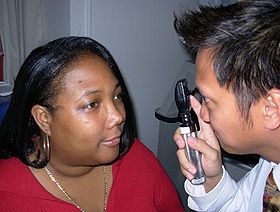Ophthalmoscopy
| Ophthalmoscopy | |
|---|---|
 Ophthalmoscopic exam: the medical provider would next move in and observe with the ophthalmoscope from a distance of one to several cm. | |
| MeSH | D009887 |
Ophthalmoscopy, also called funduscopy, is a test that allows a health professional to see inside the
The pupil is a hole through which the eye's interior will be viewed. Opening the pupil wider (dilating it) is a simple and effective way to better see the structures behind it. Therefore, dilation of the pupil (mydriasis) is often accomplished with medicated eye drops before funduscopy. However, although dilated fundus examination is ideal, undilated examination is more convenient and is also helpful (albeit not as comprehensive), and it is the most common type in primary care.
An alternative or complement to ophthalmoscopy is to perform a fundus photography, where the image can be analysed later by a professional.
Types

It is of two major types:
- Direct ophthalmoscopy one that produces an upright, or unreversed, image of approximately 15 times magnification.
- Indirect ophthalmoscopy one that produces an inverted, or reversed, image of 2 to 5 times magnification.
| Features | Direct ophthalmoscopy | Indirect ophthalmoscopy |
|---|---|---|
| Condensing lens | Not Required | Required |
| Examination distance | As close to patient's eye as possible | At an arm's length |
| Image | Virtual, erect | Real, inverted |
| Illumination | Not as bright; not useful in hazy media | Bright; useful for hazy media |
| Area of field in focus | About 2-8 disc diameters | About 8 disc diameters |
| Stereopsis | Absent | Present |
| Accessible fundus view | Slightly beyond equator[further explanation needed] | Up to Ora serrata i.e. peripheral retina |
| Examination through hazy media | Difficult to not possible | Possible |
Each type of ophthalmoscopy has a special type of ophthalmoscope:
- The direct ophthalmoscope is an instrument about the size of a small flashlight (torch) with several lenses that can magnify up to about 15 times.[1] This type of ophthalmoscope is most commonly used during a routine physical examination. The pan-ophthalmoscope has a larger primary lens with a variable focusing, allowing for a wider field-of-view.
- An indirect ophthalmoscope, on the other hand, constitutes a light attached to a headband, in addition to a small handheld lens. It provides a wider view of the inside of the eye. Furthermore, it allows a better view of the fundus of the eye, even if the lens is clouded by cataracts.[1] An indirect ophthalmoscope can be either monocular or binocular. It is used for peripheral viewing of the retina.
Medical uses
Ophthalmoscopy is done as part of a routine physical or complete eye examination, mainly done by
Dilation of the pupil
To allow for better inspection through the
History
William Cumming in 1846 at the Royal London Ophthalmic Hospital (later Moorfields Eye Hospital), of his pioneering work wrote "every eye could be made luminous if the axis from a source of illumination directed towards a person's eye and the line of vision of the observer were coincident".[2]
Although some credit the invention of the ophthalmoscope to Charles Babbage in 1847, it was not until it was independently reinvented by Hermann von Helmholtz in 1851 that its usefulness was recognized - it was to revolutionize ophthalmology.[3]
While training in France, Andreas Anagnostakis, MD, an ophthalmologist from Greece, came up with the idea of making the instrument hand-held by adding a concave mirror. Austin Barnett created a model for Anagnostakis, which he used in his practice and subsequently when presented at the first Ophthalmological Conference in Brussels in 1857, the instrument became very popular among ophthalmologists.[citation needed]
In 1915, Francis A. Welch and William Noah Allyn invented the world's first hand-held direct illuminating ophthalmoscope,[4] precursor to the device now used by clinicians around the world. This refinement and updating of von Helmholtz's invention enabled ophthalmoscopy to become one of the most ubiquitous medical screening techniques in the world today. The company Welch Allyn started as a result of this invention. In the 1970s a new ophthalmoloscope was developed with a larger primary lens allowing a 5x larger field-of-view, called the "Panoptic" or "pan ophthalmoscope".[5]
Etymology and pronunciation
The word ophthalmoscopy (
See also
- Charles Schepens
- Retinoscope
- Scanning laser ophthalmoscopy
References
- ^ a b "Ophthalmoscopy | Michigan Medicine". Healthwise. Retrieved 10 July 2019.
- ^ "Ophthalmoscopes Part 1". Retrieved 2013-01-25.
- ^ "Principles of Ophthalmoscopy". lifehugger.com. Retrieved 2009-05-24.
- ^ Hoovers Citation
- ^ Allyn, Welch. "PanOptic Ophthalmoscope". www.welchallyn.com. Retrieved 2019-01-29.
- ^ Merriam-Webster, Merriam-Webster's Medical Dictionary, Merriam-Webster.
- ^ Merriam-Webster, Merriam-Webster's Unabridged Dictionary, Merriam-Webster.
- ^ Elsevier, Dorland's Illustrated Medical Dictionary, Elsevier.
- ^ Houghton Mifflin Harcourt, The American Heritage Dictionary of the English Language, Houghton Mifflin Harcourt, archived from the original on 2015-09-25, retrieved 2015-10-21.
- ^ Wolters Kluwer, Stedman's Medical Dictionary, Wolters Kluwer.
External links
- Ophthalmoscopy on Medlineplus
- Ophthalmoscopy on WebMD
- Overview at bmjjournals.com
- Medlineplus about different types of ophthalmoscopy
